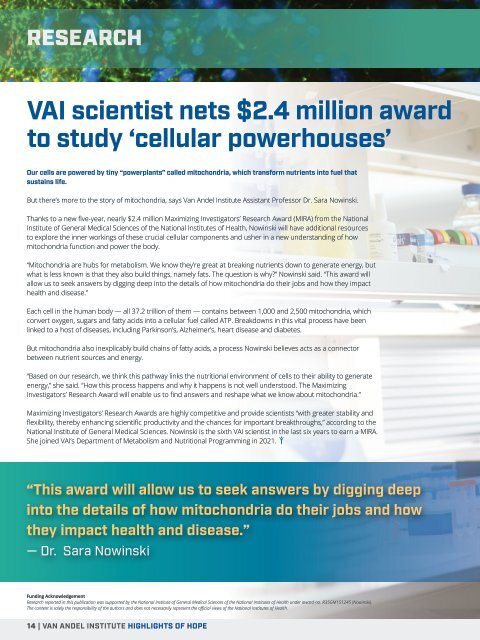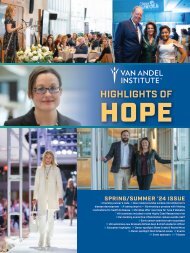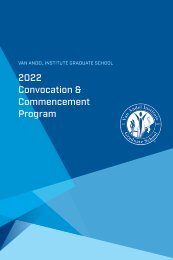2023 Fall/Winter Highlights of Hope
This is the 2023 Fall/Winter edition of Van Andel Institute's Highlights of Hope donor publication.
This is the 2023 Fall/Winter edition of Van Andel Institute's Highlights of Hope donor publication.
Create successful ePaper yourself
Turn your PDF publications into a flip-book with our unique Google optimized e-Paper software.
RESEARCH<br />
VAI scientist nets $2.4 million award<br />
to study ‘cellular powerhouses’<br />
Our cells are powered by tiny “powerplants” called mitochondria, which transform nutrients into fuel that<br />
sustains life.<br />
But there’s more to the story <strong>of</strong> mitochondria, says Van Andel Institute Assistant Pr<strong>of</strong>essor Dr. Sara Nowinski.<br />
Thanks to a new five-year, nearly $2.4 million Maximizing Investigators’ Research Award (MIRA) from the National<br />
Institute <strong>of</strong> General Medical Sciences <strong>of</strong> the National Institutes <strong>of</strong> Health, Nowinski will have additional resources<br />
to explore the inner workings <strong>of</strong> these crucial cellular components and usher in a new understanding <strong>of</strong> how<br />
mitochondria function and power the body.<br />
“Mitochondria are hubs for metabolism. We know they’re great at breaking nutrients down to generate energy, but<br />
what is less known is that they also build things, namely fats. The question is why?” Nowinski said. “This award will<br />
allow us to seek answers by digging deep into the details <strong>of</strong> how mitochondria do their jobs and how they impact<br />
health and disease.”<br />
Each cell in the human body — all 37.2 trillion <strong>of</strong> them — contains between 1,000 and 2,500 mitochondria, which<br />
convert oxygen, sugars and fatty acids into a cellular fuel called ATP. Breakdowns in this vital process have been<br />
linked to a host <strong>of</strong> diseases, including Parkinson’s, Alzheimer’s, heart disease and diabetes.<br />
But mitochondria also inexplicably build chains <strong>of</strong> fatty acids, a process Nowinski believes acts as a connector<br />
between nutrient sources and energy.<br />
“Based on our research, we think this pathway links the nutritional environment <strong>of</strong> cells to their ability to generate<br />
energy,” she said. “How this process happens and why it happens is not well understood. The Maximizing<br />
Investigators’ Research Award will enable us to find answers and reshape what we know about mitochondria.”<br />
Maximizing Investigators’ Research Awards are highly competitive and provide scientists “with greater stability and<br />
flexibility, thereby enhancing scientific productivity and the chances for important breakthroughs,” according to the<br />
National Institute <strong>of</strong> General Medical Sciences. Nowinski is the sixth VAI scientist in the last six years to earn a MIRA.<br />
She joined VAI’s Department <strong>of</strong> Metabolism and Nutritional Programming in 2021.<br />
“This award will allow us to seek answers by digging deep<br />
into the details <strong>of</strong> how mitochondria do their jobs and how<br />
they impact health and disease.”<br />
— Dr. Sara Nowinski<br />
Funding Acknowledgement<br />
Research reported in this publication was supported by the National Institute <strong>of</strong> General Medical Sciences <strong>of</strong> the National Institutes <strong>of</strong> Health under award no. R35GM151245 (Nowinski).<br />
The content is solely the responsibility <strong>of</strong> the authors and does not necessarily represent the <strong>of</strong>ficial views <strong>of</strong> the National Institutes <strong>of</strong> Health.<br />
14 | VAN ANDEL INSTITUTE HIGHLIGHTS OF HOPE
















